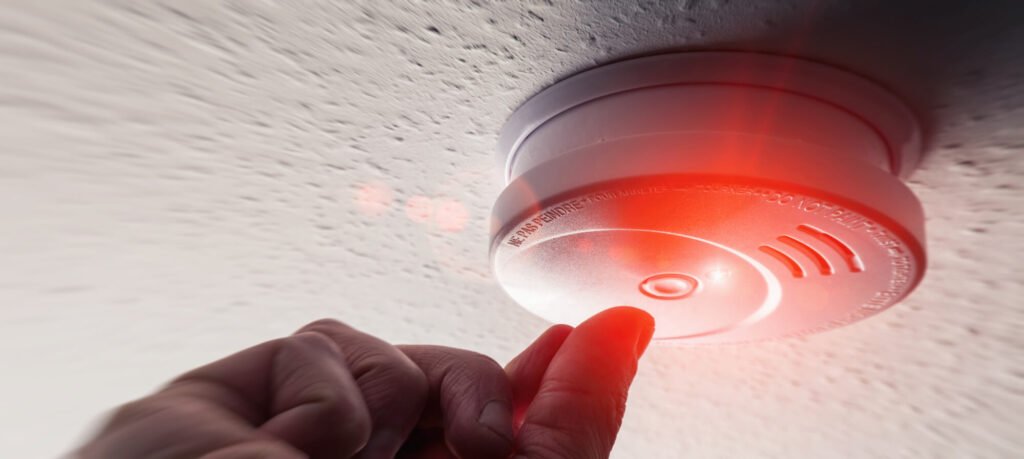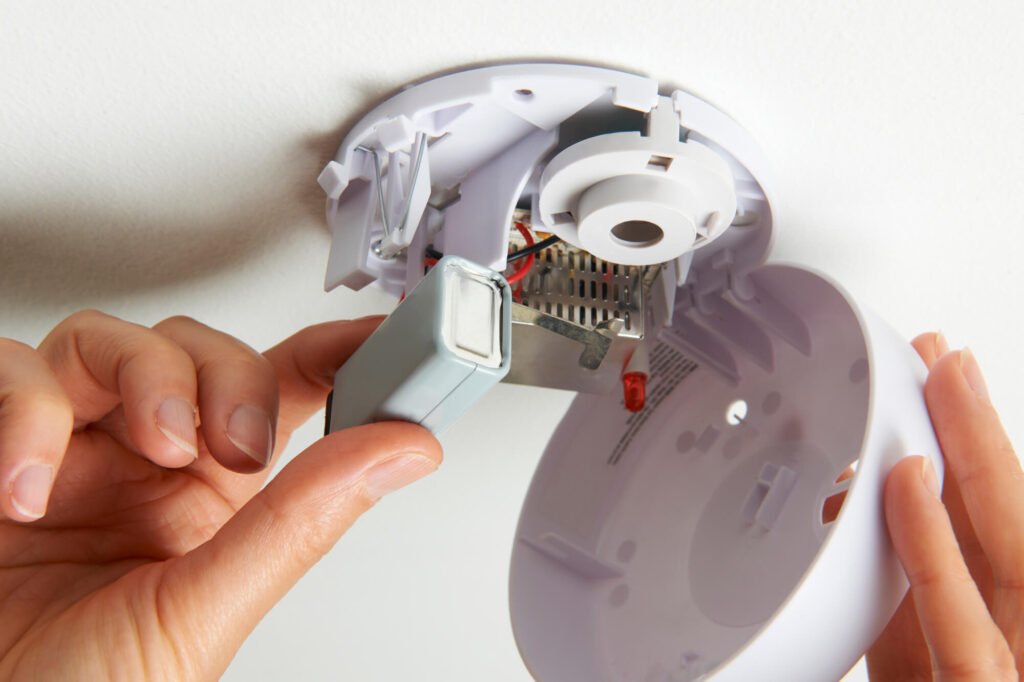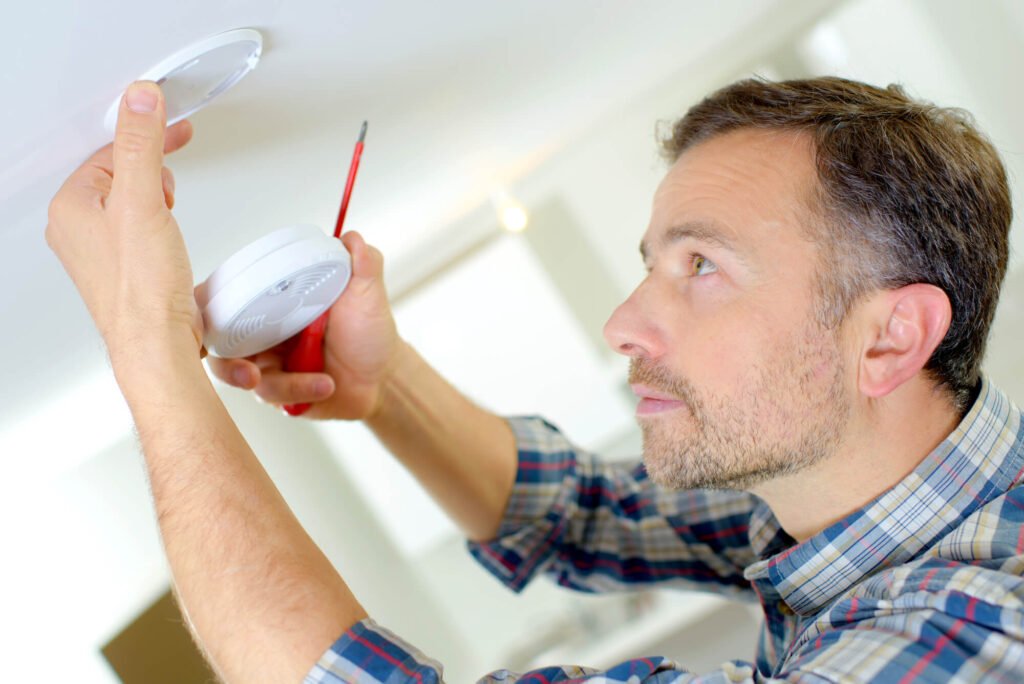

Prioritising the protection of your residence and loved ones against the peril of fire must never be overlooked. Sadly, numerous domestic fires are reported annually in Australia. Studies indicate that prompt detection of fire or its smoke significantly influences whether you and your family evade harm. This underscores the importance of smoke detectors.
In this comprehensive guide, we will explore the various complexities of smoke detectors, providing you with the knowledge needed to make well-informed decisions that safeguard your home from the danger of fire. We’ll shed light on the different smoke detectors available, legal obligations across Australia, guidance on installation, fundamental maintenance procedures, and more. Regardless of whether you’re a seasoned homeowner or a novice buyer, gaining a deep understanding of smoke alarms is vital for guaranteeing the protection and security of not only your property, but your family as well.
Understanding Smoke Alarms
Smoke alarms are designed to detect the presence of smoke or fire early on, providing you and your family with valuable time to evacuate safely. Understanding the different types of smoke alarms available, as well as their distinct features and functionalities, ensures you can setup optimal fire detection devices that are well-positioned to protect your home.
Types of Smoke Alarms
There are primarily two types of smoke alarms commonly used in residential settings: ionization smoke alarms and photoelectric smoke alarms. Each type employs a different mechanism for detecting smoke particles and has its own set of advantages and limitations.
- Ionization smoke alarms: these alarms contain a small amount of radioactive material that ionizes the air between two electrically charged plates. When smoke enters the ionization chamber, it disrupts the flow of ions, triggering the alarm. Ionization smoke alarms are particularly effective at detecting fast-flaming fires, such as those caused by burning paper or wood.
- Photoelectric smoke alarms: photoelectric smoke alarms utilise a light source and a sensor to detect smoke particles in the air. When smoke enters the chamber, it scatters the light, causing it to be detected by the sensor, thereby triggering the alarm. Photoelectric smoke alarms are highly effective at detecting smouldering fires, which produce large amounts of smoke before erupting into flames.
What is The Difference Between Smoke Alarms and Smoke Detectors?
While the terms “smoke alarm” and “smoke detector” are often used interchangeably, there is a subtle distinction between the two. Smoke alarms typically incorporate both smoke detection sensors and audible alarm components within a single unit. These standalone devices are designed to emit a loud sound when smoke is detected, alerting occupants to the presence of a potential fire.
On the other hand, smoke detectors primarily function as sensors that detect smoke or combustion products. These detectors may be part of a larger fire detection and alarm system, where they transmit signals to a central control panel or monitoring station to initiate appropriate response actions, such as activating fire sprinklers or automatically notifying emergency services.


Choosing The Right Smoke Alarm
Choosing the best type of smoke alarm for your home depends on various factors, including the layout of your property, the types of fire hazards present, and your personal preferences. While both ionization and photoelectric smoke alarms offer reliable fire detection capabilities, experts generally recommend photoelectric smoke alarms for residential use due to their effectiveness at detecting smouldering fires, which are more common in household settings.
This recommendation aside, when selecting a smoke alarm for your home, there are several factors to consider to ensure you make the best choice for your unique needs. Here’s what to look for:
- Type of alarm: decide between ionization and photoelectric smoke alarms based on the type of fire you want to detect. Photoelectric alarms are generally recommended as they are more effective at detecting smouldering fires, which can produce more smoke before flames appear.
- Power source: smoke alarms can be battery-powered or hardwired into your home’s electrical system. Battery-powered alarms are easy to install and can be placed anywhere, while hardwired alarms are more reliable as they are not dependent on battery life. Consider whether your home has existing wiring for hardwired alarms. if you do opt for a battery-powered smoke alarm, choose one with a long-lasting battery, preferably a 10-year lithium battery. This ensures minimal maintenance and reliable operation over an extended period.
- Testing and maintenance features: look for smoke alarms with convenient testing and maintenance features such as a test button for regular checks, low battery indicators, and hush buttons to silence false alarms.
- Compliance with standards: ensure that the smoke alarm complies with Australian standards for safety and performance (AS 3786). Look for certification or registration from recognised authorities to guarantee product reliability.
- Additional features: some smoke alarms come with additional features like escape lights for visibility during emergencies or interconnectivity to trigger all alarms in the house simultaneously.
The cost of smoke alarms can vary depending on factors such as type, brand, and additional features. Generally, basic models start from around $10, while more advanced models with additional features can range up to $100 or more. Remember, investing in a reliable smoke alarm is a small price to pay for the safety and security of your family and home.
Smoke Alarm Laws in Australia
In Australia, smoke alarms are not just recommended; they are legally required in most residential properties. Understanding the specific requirements in your state or territory is crucial to ensure compliance with the law. Here’s an overview of smoke alarm laws across different regions:
- New South Wales (NSW): Fire and Rescue NSW mandates a minimum of one smoke alarm per level, with additional recommendations for placement in bedrooms, living spaces, hallways, and stairways. Photoelectric alarms are recommended.
- Victoria (VIC): Fire Rescue Victoria requires at least one smoke alarm per home, with a preference for photoelectric alarms.
- Queensland (QLD): QLD Fire and Emergency Services specify the installation of photoelectric alarms on each storey, either mains-powered or with a 10-year battery.
- South Australia (SA): The Government of South Australia requires at least one smoke alarm per home, with many properties needing mains-powered or 10-year battery models.
- Western Australia (WA): The Department of Fire & Emergency Services mandates the installation of mains-powered smoke alarms per level, with battery-powered options allowed if mains power is unavailable.
- Northern Territory (NT): Northern Territory Fire & Rescue Services require all residential properties to have at least one working smoke alarm, transitioning to mains-powered or 10-year battery photoelectric alarms.
- Australian Capital Territory (ACT): the ACT Emergency Services Agency stipulates that all homes built or renovated since 1997 must have at least one mains-powered alarm, with photoelectric smoke alarms recommended.
- Tasmania (TAS): the Tasmanian Government requires all homes and rental properties to have at least one mains-powered or 10-year lithium battery smoke alarm per home.
Failure to adhere to smoke alarm laws can result in penalties and, more importantly, compromise the safety of occupants in the event of a fire.


Installation of Smoke Alarms
Proper placement of smoke alarms is crucial for early detection of fires and ensuring the safety of occupants.
In single-storey homes, it’s recommended to install at least one smoke alarm in the center of the living room and another along the corridor leading to the bedrooms. For multi-storey homes, the recommendation is to have at least one smoke alarm on every storey. However, if the circulation area of a storey exceeds 70 square meters, it’s advisable to consider installing at least two smoke detectors to ensure adequate coverage.
When installing your smoke alarm, it’s important to avoid dead air spaces where smoke may not reach the detectors. Additionally, smoke alarms should be installed at least four inches away from walls or corners to prevent false alarms and ensure optimal detection.
Maintenance of Smoke Alarms
It’s crucial you perform routine upkeep of your smoke alarms to guarantee their effectiveness. Here are some upkeeping activities to maintain the condition of your smoke alarms:
- Monthly testing: test your smoke alarms monthly by pressing the test button to ensure that they are functioning correctly (if they have a test button).
- Battery replacement: replace batteries in battery-powered smoke alarms at least once a year or according to the manufacturer’s recommendations. Consider using long-life lithium batteries for extended durability.
- Cleaning: regularly clean smoke alarms to remove dust, dirt, and debris that may obstruct the sensors. Use a vacuum cleaner or soft brush to clean the vents and sensor chamber.
- Replacement: replace smoke alarms every 10 years or according to the manufacturer’s recommendations, even if they appear to be functioning correctly. Over time, smoke alarms may lose their sensitivity and become less reliable.
By following these very simple maintenance guidelines, you can ensure that your smoke alarms remain effective in detecting smoke and alerting you to potential fire hazards, providing valuable time for evacuation and minimising property damage.
Conclusion
Smoke alarms are essential devices that play a critical role in safeguarding your home and family against the devastating effects of fires. Whether you live in a single-storey house or a multi-storey dwelling, installing smoke alarms in strategic locations throughout your home is a proactive measure that can save lives.
As a homeowner, it’s your responsibility to ensure that your smoke alarms are properly installed, regularly maintained, and in good working condition. If you’re unsure about the placement or installation of smoke alarms in your home, consider consulting a licensed electrician who can provide expert advice and assistance. Remember, the safety of your loved ones should always be a top priority. Stay proactive in protecting your home and family by having smoke alarms installed and maintained by qualified electricians on the Central Coast and Newcastle areas.
